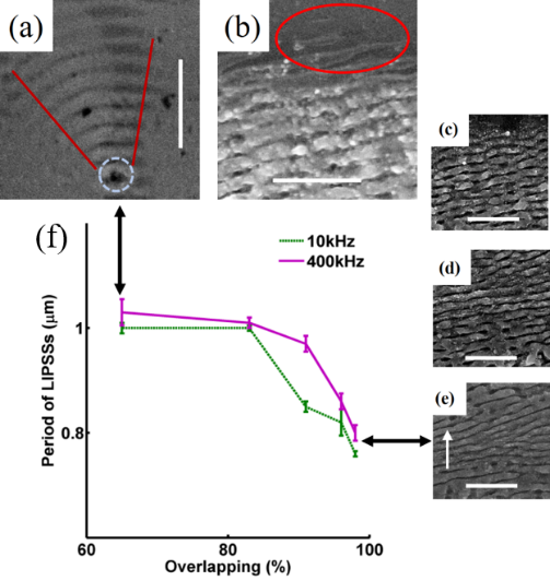Femtosecond laser induced periodic surface structures (fs-LIPSSs) on various materials, such as metals, semiconductors, and dielectrics, have gained considerable attraction, and hold many potential applications in enhancing tungsten filament luminous efficiency, enhancement of optical absorption and photocurrent, metal colorization, terahertz emitting enhancement, modulation of tribological property, and super-hydrophobic modification, etc.
The dependence of the surface morphology, such as spatial period, orientation and depth, on laser fluence, pulse overlapping rate, incident angle, laser polarization, pulse duration, wavelength, etc, have been extensively investigated. However, the mechanism of high-repetition LIPSS formation seems to be even more complex and few papers are reported.
The research group led by Prof. Quanzhong Zhao from Shanghai Institute of Optics and Fine Mechanics, Chinese Academy of Sciences found that high-repetition rate femtosecond lasers can drive heat accumulation processes which are attractive for femtosecond laser induced subwavelength periodic surface structures on silicon. The research results are published in Chinese Optics Letters, Vol. 21, Issue 5, 2023 (Q. Fu, et al., Heat accumulation effects in femtosecond laser induced subwavelength periodic surface structures on silicon).
It was demonstrated in this work that femtosecond laser micro-machining is no longer a non-thermal process as long as repetition rate reaches up to 100 kHz due to heat accumulation. Moreover, higher repetition rate generates more defined ripple structures on silicon surface, based on the fact that accumulated heat raises lattice temperature to the melting point of silicon (1687 K) with more intense surface plasmons (SPs) excited simultaneously. Comparison of the surface morphology on repetition rate and on overlapping rate confirms that repetition rate and pulse overlapping rate are two competing factors which are responsible for the period of ripple structures. Ripple period is drifted towards longer by higher repetition rate due to increasing electron density; however, the period of laser structured surface is reduced with pulse overlapping rate. Moreover, Maxwell–Garnett effect is confirmed to account for ripple period-decreasing trend with pulse overlapping rate.
Dr. Qiang Fu from Shanghai Institute of Optics and Fine Mechanics, Chinese Academy of Sciences believes that high-repetition rate femtosecond lasers are effective tools for the fabrication of fs-LIPSSs. In the further study, higher repetition rates ranging to MHz will be investigated.

Figure 1. SEM images of ripple structures induced by femtosecond laser pulses under pulse overlapping rates of (a) 65%, (b) 83%, (c) 91%, (d) 96% and (e) 98% at a repetition rate of 400 kHz. (f) The period of ripples as a function of pulse overlapping rate at repetition rate of 10 and 400 kHz. (SEM magnification: 3500; Scale bar: 5μm; white arrow: laser polarization.)


